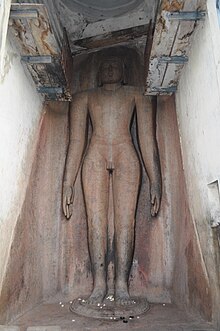Tamil Jain
They are predominantly scattered in northern Tamil Nadu, largely in the districts of Tiruvannamalai, Kanchipuram, Vellore, Villupuram, Ranipet and Kallakurichi.[2] Some scholars believe that Jain philosophy must have entered South India some time in the sixth century BCE.[citation needed] According to other scholars, Jainism must have existed in South India well before the era of Jain tirthankara Lord Mahaveer Swami.[citation needed] A number of Tamil-Brahmi inscriptions have been found in Tamil Nadu that date from the second century BCE.The Ramayana mentions that Rama paid homage to Jain monks living in South India on his way to Sri Lanka.Some scholars believe that the author of the oldest extant work of literature in Tamil (3rd century BCE), Tolkāppiyam, was a Jain Shraman.[8] It emphatically supports strict vegetarianism (or veganism) (Chapter 26) and states that giving up animal sacrifice is worth more than thousand burnt offerings (verse 259).This epic is a major work in Tamil literature, describing the historical events of its time and also of then-prevailing religions, Jainism, Buddhism and Shaivism.The main characters of this work, Kannagi and Kovalan, who have a divine status among Tamils, Malayalees and Sinhalese were Jains.[citation needed] According to George L. Hart, who holds the endowed chair in Tamil Studies by University of California, Berkeley, has written that the legend of the Tamil Sangams or "literary assemblies", was based on the Jain sangham at Madurai: There was a permanent Jain assembly called a Sangha established about 604 CE in Madurai.[10] Jainism began to decline around the eighth century CE, with many Tamil kings embracing Hindu religions, especially Shaivism.[31] While some of the Jains assign this conversion to the period of the Bhakti movement in Tamil nadu others link it to a conflict with a ruler of the Vijayanagara empire in the 15th century.Laxmisena of the Jina Kanchi Jain Mutt or madam at Mel-Sithamoor (near Tindivanam, Villupuram District) is one of the religious heads of the community.Planting of coconut and mango trees has been started to increase the revenue of the fund for the purpose of day-to-day maintenance of the mutt.Now in the mutt around 2300 students are studying from primary to higher secondary school including Jain philosophy with free boarding and lodging.Pilgrimage - most Jains go on pilgrimage to tirthas and major Jain temples in North India - Sammed Shikharji, Pavapuri, Champapuri and Urjayanta Giri - as well as places in South India such as Shravanabelagola, Humcha or Hombuja Humbaj, Simmanagadde in Karnataka and Ponnur Malai in Tamil Nadu.



BhattarakaLaxmisenaMel SithamurJainismHistoryTimelinePhilosophyAnekantavadaCosmologyAhimsaDharmaMokṣaKevala JnanaDravyaTattvaBrahmacaryaAparigrahaGunasthanaSaṃsāraEthics of JainismAhiṃsā (non-violence)Aparigraha (non-possession)SāmāyikaSallekhanaBhaktamara StotraMicchami DukkadamNavkar MantraṆamōkāra mantraJai JinendraThe 24 TirthankarasRishabhaPārśvaMahaviraArihantGanadharaKundakundaSiddhasenadivākarasuriSamantabhadraHaribhadraYashovijayaSchools and BranchesDigambaraŚvetāmbaraJain literatureSamayasāra (Digambara)Pravachanasara (Digambara)Agama (Śvetāmbara)Tattvartha SutraDravyasamgraha (Digambara)Kalpa Sūtra (Śvetāmbara)Uttaradhyayana (Śvetāmbara)Cīvaka CintāmaṇiSilappatikaramValayapathiDiwaliMahavir Janma KalyanakParyushanaSamvatsariPalitanaGirnarShikharjiShravanabelagolaEkendriyaTemplesJain flagJain symbolsParasparopagraho JivanamTopics listMel Sithamur Jain MathPrakritsamaṇaTamilsIndian stateTamil NaduTiruvannamalaiKanchipuramVelloreVillupuramRanipetKallakurichiTamil-BrahmiTamil literatureSangam literatureNālaṭiyārCilappatikaramCivaka CintamaniJambaiTamil BrahmiSouth IndiaMaduraiTiruchirāppaḷḷiKanyakumariThanjavurSangam periodRamayanaJain monksSri LankaTolkāppiyamTirukkuralThiruvalluvarvegetarianismveganismIlango AdigalShaivismKannagiKovalanMalayaleesSinhaleseGeorge L. HartUniversity of CaliforniaBerkeleyTamil SangamsHindu religionsChalukyaPallavaPandyaimpalement of the Jains in MaduraiPaul DundasAkalankaKanchiMadras StateBharatiya Digambar Jain Tirth Samrakshini MahasabhaKancheepuram districtyakshiniAmbikatirthankara